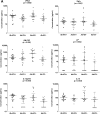Children with islet autoimmunity and enterovirus infection demonstrate a distinct cytokine profile
- PMID: 22474026
- PMCID: PMC3357262
- DOI: 10.2337/db11-0264
Children with islet autoimmunity and enterovirus infection demonstrate a distinct cytokine profile
Abstract
Cytokines are upregulated in prediabetes, but their relationship with Enterovirus (EV) infection and development of islet autoimmunity is unknown. Cytokines (n = 65) were measured using Luminex xMAP technology in a nested case-control study of 67 children with a first-degree relative with type 1 diabetes: 27 with islet autoantibodies (Ab(+)) and 40 age-matched persistently autoantibody negative (Ab(-)) control subjects. Of 74 samples, 37 (50%) were EV-PCR(+) in plasma and/or stool (EV(+)) and the remainder were negative for EV and other viruses (EV(-)). Fifteen cytokines, chemokines, and growth factors were elevated (P ≤ 0.01) in Ab(+) versus Ab(-) children (interleukin [IL]-1β, IL-5, IL-7, IL-12(p70), IL-16, IL-17, IL-20, IL-21, IL-28A, tumor necrosis factor-α, chemokine C-C motif ligand [CCL]13, CCL26, chemokine C-X-C motif ligand 5, granulocyte-macrophage colony-stimulating factor, and thrombopoietin); most have proinflammatory effects. In EV(+) versus EV(-) children, IL-10 was higher (P = 0.005), while IL-21 was lower (P = 0.008). Cytokine levels did not differ between Ab(+)EV(+) and Ab(+)EV(-) children. Heat maps demonstrated clustering of some proinflammatory cytokines in Ab(+) children, suggesting they are coordinately regulated. In conclusion, children with islet autoimmunity demonstrate higher levels of multiple cytokines, consistent with an active inflammatory process in the prediabetic state, which is unrelated to coincident EV infection. Apart from differences in IL-10 and IL-21, EV infection was not associated with a specific cytokine profile.
Figures




References
-
- Eizirik DL, Colli ML, Ortis F. The role of inflammation in insulitis and beta-cell loss in type 1 diabetes. Nat Rev Endocrinol 2009;5:219–226 - PubMed
-
- Hanifi-Moghaddam P, Kappler S, Seissler J, et al. Altered chemokine levels in individuals at risk of type 1 diabetes mellitus. Diabet Med 2006;23:156–163 - PubMed
-
- Stechova K, Bohmova K, Vrabelova Z, et al. High T-helper-1 cytokines but low T-helper-3 cytokines, inflammatory cytokines and chemokines in children with high risk of developing type 1 diabetes. Diabetes Metab Res Rev 2007;23:462–471 - PubMed
Publication types
MeSH terms
Substances
LinkOut - more resources
Full Text Sources
Other Literature Sources
Medical
Research Materials
Miscellaneous

